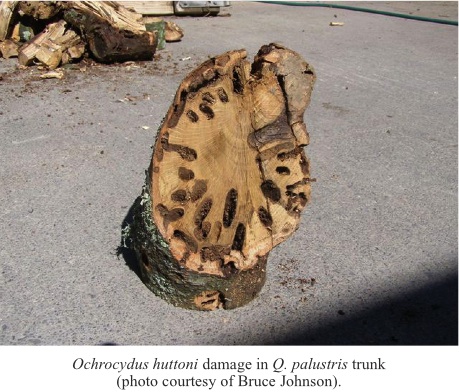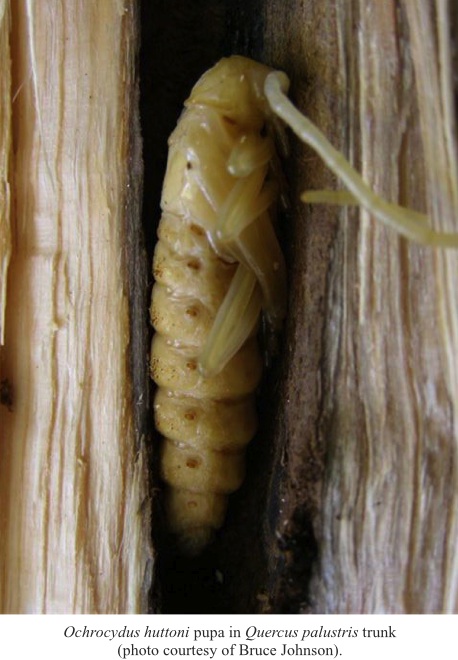PESTS AND DISEASES OF FORESTRY IN NEW ZEALAND
Ochrocydus huttoni (kanuka longhorn) in Quercus palustris (pin oak)
Scion is the leading provider of forest-related knowledge in New Zealand
Formerly known as the Forest Research Institute, Scion has been a leader in research relating to forest health for over 50 years. The Rotorua-based Crown Research Institute continues to provide science that will protect all forests from damage caused by insect pests, pathogens and weeds. The information presented below arises from these research activities.
 From Forest Health News 171, March 2007.
From Forest Health News 171, March 2007.
New host record for New Zealand – Insect: Ochrocydus huttoni (Cerambycidae); Region: Wellington; Host: Quercus palustris ; Coll: B. Johnson, 22/03/2007; Ident: J Bain, 27/03/2007;
Comments: This native longhorn beetle is a common live-stem borer in Leptospermum scoparium, Kunzea ericoides , and Nothofagus spp. There are also records (one each) from Quercus cerris, Q. coccinea, and Agonis juniperina.
The damage to the Quercus palustris trees was very severe.
 From Forest Health News No. 172, April 2007.
From Forest Health News No. 172, April 2007.
The new records section of last month’s Forest Health News gave brief details of Ochrocydus huttoni (kanuka longhorn) in Quercus palustris (pin oak). This interesting record deserves elaboration.
Ochrocydus huttoni is a native species that normally bores in the live stems and larger branches of Leptospermum scoparium, Kunzea ericoides, and Nothofagus spp. The larvae excavate longitudinal tunnels in the host, and make short lateral tunnels to the surface through which frass is ejected. The longitudinal tunnels can exceed 1 m in length and are about 15 mm at their widest point. An accumulation of frass on the lower stem or on the ground is generally an indication of advanced infestation.
The oaks in question here are on a golf course and the most severely affected are about 40–60 years old, although much younger trees are also damaged. There are several other species of oak planted on the golf course but the O. huttoni damage has been noted only on Q. palustris . Interestingly there are no signs of O. huttoni damage in K. ericoides or N. solandri which are also present on the golf course.
The most severely affected Q. palustris trees are showing signs of decline; this was first noticed when the trees were flushing in the spring. Such decline has not been noted in Leptospermum, Kunzea, and Nothofagus spp. even with heavy infestations. The most severely affected trees are being removed and others are being treated by stem injections using a systemic insecticide.
The Forest Health Database and insect collection also have records of O. huttoni from Quercus cerris, Q. coccinea, and Agonis juniperina.
John Bain
This information is intended for general interest only. It is not intended to be a substitute for specific specialist advice on any matter and should not be relied on for that purpose. Scion will not be liable for any direct, indirect, incidental, special, consequential or exemplary damages, loss of profits, or any other intangible losses that result from using the information provided on this site.
(Scion is the trading name of the New Zealand Forest Research Institute Limited.)

 Farm Forestry New Zealand
Farm Forestry New Zealand

